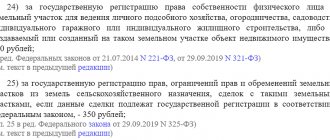Elena Shereshovets spoke about the formation and maintenance of the MKD land plot
On the first day of the online seminar, the Head of the Expert Council of the P1 Association, Elena Shereshovets, examined what changes have occurred in the legislation in the field of land and real estate in 2021. We also discussed topics such as:
- formation of a site for an apartment building;
- protection of the rights of premises owners during its registration;
- transfer of ownership of the site.
Among these issues, we discussed the topic of responsibility for the maintenance of the land.
Watch the demo on the YouTube channel of the P1 Association ➡️
How to privatize land under an apartment building
Where to start privatization? The privatization procedure itself is not required as such. It is enough to simply issue a cadastral passport for the plot, after which the land will automatically become the property of the residents of the apartments in the building.
Order and stages
- Hold a meeting of all residents of the house.
- Agree on the fact of registration of the site as property.
- Select a representative who will deal with this issue.
- Draw up an application for the formation of a site.
- Send an application to the local administration.
- Request a cadastral engineer to prepare land surveying.
- Prepare documentation for registering the territory with cadastral registration.
- Contact Rosreestr for a cadastral passport.
Procedure and process
After the meeting of residents, provided that it was carried out according to the rules (see the list of documents for this below), you need to contact the local administration.
Example : In Moscow, this is done by the DGI (Department of City Property).
As part of its duties, the administration first checks whether land surveying has been carried out. If yes, an order is issued to approve the boundaries of the territory on the cadastral map. If not, a land surveying procedure is prescribed. This is done by a cadastral engineer. The survey plan is placed in a special electronic storage. This is more convenient than receiving this document in person, as it allows you to simply indicate the number of the electronic document when you subsequently issue a cadastral passport.
Next, you need to send the documents to Rosreestr. This can be done both in the structural divisions of this organization and through multifunctional centers (MFC). You can also send papers by mail or create an appeal through the Rosreestr website. After paying the state fee, checking the documentation and issuing a cadastral passport, the territory is considered the property of all residents of the house. No additional certificates of ownership will be issued.
Owners pay for the maintenance of the land plot, which is part of the common property of the house
Management organizations are responsible for the maintenance of the land plot if it is formed and is part of the common property. The common property of the residents of the house is a plot with the following characteristics:
- it has been formed (clause 4, part 1, article 36 of the RF Housing Code);
- its boundaries and size are determined in accordance with the requirements of the law (clause “e”, clause 2 of RF PP No. 491);
- State cadastral registration was carried out in its respect (Part 5, Article 16 of the Federal Law of December 29, 2004 No. 189-FZ).
The land plot is transferred into ownership free of charge from the moment of its formation. Until this time, it is the property of a public legal entity (clause 67 of the resolution of the Plenum of the Supreme Court of the Russian Federation, Supreme Arbitration Court of the Russian Federation dated April 29, 2010 No. 10/22).
Elena Shereshovets noted that if the boundaries of the land plot adjacent to the apartment building are not established, the plot itself is not specified, there is no plan diagram, the management authority is not obliged to maintain such a territory. Citizens and legal entities are responsible only for the condition of the plots that are in their ownership or possession.
In this case, authorities or a court may oblige owners to maintain the territory adjacent to their land plots - on the basis of federal law or an agreement. This conclusion was made by the Supreme Court of the Russian Federation in paragraph 7 of the Review of Judicial Practice No. 4 (2018). Find out more from the online seminar materials below the article.
Can the local self-government not form a plot for an apartment building in the absence of money?
Material costs during registration
The privatization process is carried out free of charge.
Paperwork involves material costs:
- upon receipt of cadastral documentation, material costs will be approximately 10,000 rubles;
- the cost of technical documentation varies depending on regional BTI prices;
- registration of rights in the Unified State Register of Real Estate – 500 rubles;
- legal entity – 2,000.
It is worth noting that the cost of services must be clarified in regional divisions.
The management authority is responsible for the condition of the local area included in the general property of the apartment building
Owners of premises in apartment buildings bear the burden of expenses for the maintenance of common property (Parts 1, 3, Article 39 of the Housing Code of the Russian Federation). At the same time, the management organization ensures its proper maintenance (Article 161 of the RF Housing Code).
According to Art. 162 of the Housing Code of the Russian Federation, the common property of an apartment building is an essential condition of the management agreement. The property of the house includes only a formed land plot, the boundaries of which are determined on the basis of state cadastral registration data (clause “e”, clause 2 of RF PP No. 491). In this case, the owners of premises in an apartment building pay for its maintenance (Article 154 of the Housing Code of the Russian Federation).
As Elena Shereshovets noted, the management organization is responsible for maintaining the local area only if two conditions coincide:
- The site is the common property of the owners of premises in the apartment building.
- Territory maintenance services are included in the management agreement.
Watch the full video of the first day of the online seminar to learn what to do if local regulations and courts are in favor of requiring the HO to maintain an undeveloped area of the house.
Taxes
Article 338 of the Tax Code of the Russian Federation defines the procedure for establishing the amount of tax fees for a site located near an apartment building. Local regulations also influence the size and procedure of payment.
The tax is determined based on the base land tax rate, cadastral value and local coefficient. Therefore, different amounts of mandatory tax may be charged for the same area of land in different parts of Russia.
You must pay the tax once a year. Individual entrepreneurs and legal entities are required to pay the tax fee themselves, and individuals are calculated and notified of the payment amount, date and method of payment by the Federal Tax Service of the Russian Federation.
There are no criteria in the regulatory legal acts for assessing the sanitary condition of the local area of the house
On the second day of the online seminar, the Chairman of the Board of the P1 Association, the head of RosKvartal, Boris Valit, focused on practical topics related to the land plot under an apartment building. We have sorted out:
- who should maintain the roads;
- what are the requirements for MSW accumulation sites;
- how to install a barrier and road signs in the yard;
- how to take part in the national project “Comfortable Urban Environment”.
You can learn briefly about these topics from the demo video:
Watch the demo on the YouTube channel of the P1 Association ➡️
One of the questions that Boris Valit considered was whether there are any criteria for assessing the pollution of the local area. They are not established by law. The regulations stipulate only the requirements for the composition, frequency and order of work for the proper maintenance of local areas.
The expert cited regional practice as an example - decision of the Tver City Duma dated October 16, 2014 No. 368. Clauses 6.140–6.145 of this document state how often the yard should be cleaned and its sequence.
First, they clean the sidewalks, then the pedestrian paths and courtyard areas. Cleaning, except for snow removal, which is carried out during snowfalls, is carried out until 13.00. When manually clearing sidewalks and internal driveways, snow must be removed completely, under a scraper. In the absence of improved coatings, the snow is removed under the engine, leaving a layer for subsequent compaction.
Based on this, we can conclude that if the territory is not cleaned according to the standards established in this document, then it can be considered contaminated. To avoid this, the management company and the homeowners association must carry out all work prescribed by law in full, within the specified time frame or at the established frequency. There are no other criteria for assessing the quality of work performed.
Is it possible to place commercial objects in the local area?
Deadlines
The meeting of residents is not limited by any deadlines, however, it should be taken into account that people may have their own plans and therefore it is necessary to warn about the meeting long before it starts. It is recommended to focus on a period of 1 month or more. Direct land surveying and the work of a cadastral engineer take two weeks or more. And it takes about two more weeks to obtain a cadastral passport. On average, the entire procedure will take about 3-4 months.
Other issues regarding the maintenance of a site under an apartment building can be found in the materials of the online seminar
During the two days of the online seminar, together with Elena Shereshovets and Boris Valit, we discussed many topics and issues that relate to the maintenance of land plots for apartment buildings. Including sorted out:
- what is an easement?
- what to do if excavations begin in the courtyard of the house;
- how to install road signs in the local area;
- how to raise additional money for landscaping.
You will learn more information from the videos: they are attached immediately below the article. You will find reviews of judicial practice, algorithms and advice, and answers to questions from participants.
Controversial issues
Often problems with registration arise due to incorrect measurements of the area under a multi-story building. Therefore, when carrying out this procedure, it is desirable that the majority of residents be present. It is important to do everything correctly and without mistakes the first time. The second privatization will already be paid. Do not forget about qualified assistance from specialists.
Dear visitors to our site, we hope that we were able to fully cover the topic that interests you. Anyone who liked the material can share this information on the forum or on social networks. We will be glad to receive your comments, opinions, examples from personal experience. If you have any questions, please contact our lawyer at the specified phone number.
Advantages and disadvantages
Privatization of the territory under a multi-apartment residential building has its pros and cons, which should be analyzed in advance in order to decide whether the site should be privatized or left under state management. The advantages of converting land into joint ownership include:
- Possibility to use the territory at your own discretion . While any buildings can be freely built on non-privatized land (for example, shops, bars, car washes, etc.), the territory transferred to the owners can be landscaped independently. For example, equip a children's or sports ground, convenient parking for cars.
- Earth protection . As long as local areas are in municipal ownership, the state has every right to seize the land for use for its own purposes. Local governments can no longer freely dispose of privatized land. If the seizure of the plot cannot be avoided, the state must pay monetary compensation to each land owner.
- Commercial use . Residents who have privatized a plot have the right to benefit from renting out the land. For example, if entrepreneurs are interested in a plot of land, the owners of shared property will receive a stable profit by providing the land for commercial lease (find out how to privatize leased land in this article).
However, despite the obvious advantages, the process of converting land into joint ownership also has its disadvantages:
- Responsibility to independently maintain and improve the territory. Any work on improvement of the land plot (for example, installation of children's play complexes or landscaping of the territory) and associated costs will be borne by the owners.
- The owners of the site will also have to answer for the repair of objects located on the territory of privatized land.
- Penalties. If the local area is not maintained properly, this may result in fines being imposed. For example, for organizing unauthorized parking, untimely snow removal or garbage removal.
By receiving land ownership, residents receive more rights and freedoms to use it. But at the same time, they have to fulfill certain requirements for maintaining the site in order to avoid penalties.
Reasons for refusal
Since the adjacent territory is often a desirable acquisition not only for owners of apartments in a high-rise building, but also for developers of various commercial real estate, there are often situations when it is necessary to go to court in order to finally delimit the ownership of the land. Therefore, privatization may be refused if the territory near the house is the subject of legal proceedings.
Another common reason for refusal is the lack of a boundary plan or cadastral passport of the site. After completing these documents, you have the opportunity to again submit an application to the municipality for the privatization of a plot of land near your house.
If all the documents are in order, then you most likely will not receive a refusal to privatize the common area - it is beneficial for local authorities to shift the responsibility for maintenance onto the shoulders of home owners.
But if, nevertheless, you were refused, and you think that it was unreasonable, then file a claim in court - this is the only authority that can put an end to the dispute about privatization.









